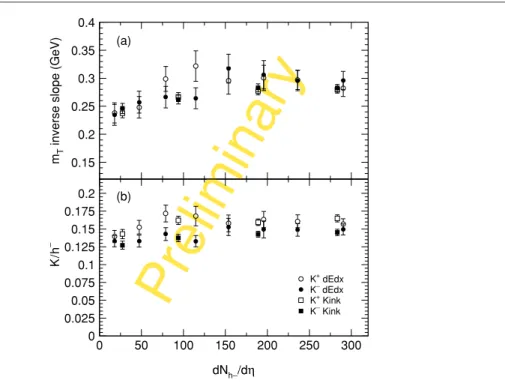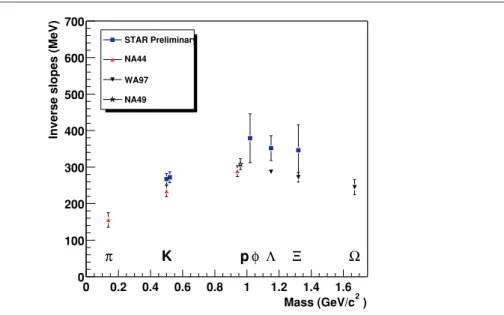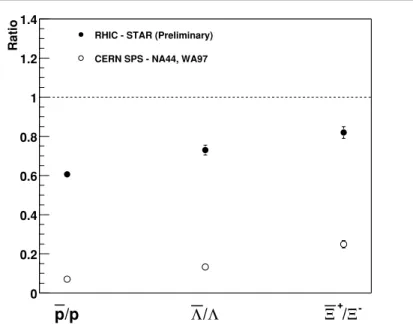J. Phys. G: Nucl. Part. Phys.28(2002) 1535–1542 PII: S0954-3899(02)32983-9
Strangeness in Au+Au collisions at √ s
NN= 130 GeV observed with the STAR detector
Lee S Barnby for the STAR Collaboration: C Adler11, Z Ahammed23, C Allgower12, J Amonett14, B D Anderson14, M Anderson5,
G S Averichev9, J Balewski12, O Barannikova9,23, L S Barnby14,
J Baudot13, S Bekele20, V V Belaga9, R Bellwied31, J Berger11, H Bichsel30, L C Bland12, C O Blyth3, B E Bonner24, A Boucham26, A Brandin18, R V Cadman1, H Caines20, M Calder´on de la Barca S´anchez33, A Cardenas23, J Carroll15, J Castillo26, M Castro31, D Cebra5,
S Chattopadhyay31, M L Chen2, Y Chen6, S P Chernenko9, M Cherney8, A Chikanian33, B Choi28, W Christie2, J P Coffin13, T M Cormier31, J G Cramer30, H J Crawford4, W S Deng14, A A Derevschikov22, L Didenko2, J E Draper5, V B Dunin9, J C Dunlop33, V Eckardt16, L G Efimov9, V Emelianov18, J Engelage4, G Eppley24, B Erazmus26, P Fachini25, V Faine2, K Filimonov15, E Finch33, Y Fisyak2, D Flierl11, K J Foley2, J Fu15, C A Gagliardi27, N Gagunashvili9, J Gans33,
L Gaudichet26, M Germain13, F Geurts24, V Ghazikhanian6, J Grabski29, O Grachov31, V Grigoriev18, M Guedon13, E Gushin18, T J Hallman2, D Hardtke15, J W Harris33, M Heffner5, S Heppelmann21, T Herston23, B Hippolyte13, A Hirsch23, E Hjort15, G W Hoffmann28, M Horsley33, H Z Huang6, T J Humanic20, H H ¨ummler16, G Igo6, A Ishihara28, Yu I Ivanshin10, P Jacobs15, W W Jacobs12, M Janik29, I Johnson15, P G Jones3, E G Judd4, M Kaneta15, M Kaplan7, D Keane14, J Kiryluk6, A Kisiel29, J Klay15, S R Klein15, A Klyachko12, A S Konstantinov22, L Kotchenda18, A D Kovalenko9, M Kramer19, P Kravtsov18, K Krueger1, C Kuhn13, A I Kulikov9, G J Kunde33, C L Kunz7, R Kh Kutuev10, A A Kuznetsov9, L Lakehal-Ayat26, M A C Lamont3, J M Landgraf2, S Lange11, C P Lansdell28, B Lasiuk33, F Laue2, A Lebedev2, R Lednick´y9, V M Leontiev22, M J LeVine2, Q Li31, S J Lindenbaum19, M A Lisa20, F Liu32, L Liu32, Z Liu32, Q J Liu30, T Ljubicic2, W J Llope24,
G LoCurto16, H Long6, R S Longacre2, M Lopez-Noriega20, W A Love2, D Lynn2, R Majka33, S Margetis14, C Markert33, L Martin26, J Marx15, H S Matis15, Yu A Matulenko22, T S McShane8, F Meissner15,
Yu Melnick22, A Meschanin22, M Messer2, M L Miller33, Z Milosevich7, N G Minaev22, J Mitchell24, V A Moiseenko10, C F Moore28, V Morozov15, M M de Moura31, M G Munhoz25, J M Nelson3, P Nevski2, V A Nikitin10, L V Nogach22, B Norman14, S B Nurushev22, G Odyniec15, A Ogawa21, V Okorokov18, M Oldenburg16, D Olson15, G Paic20, S U Pandey31, Y Panebratsev9, S Y Panitkin2, A I Pavlinov31, T Pawlak29, V Perevoztchikov2, W Peryt29, V A Petrov10, J Pluta29, N Porile23, J Porter2, A M Poskanzer15, E Potrebenikova9, D Prindle30, C Pruneau31, S Radomski29, G Rai15, O Ravel26, R L Ray28, S V Razin9,12, D Reichhold8,
0954-3899/02/071535+08$30.00 © 2002 IOP Publishing Ltd Printed in the UK 1535
J G Reid30, F Retiere15, A Ridiger18, H G Ritter15, J B Roberts24, O V Rogachevski9, J L Romero5, C Roy26, V Rykov31, I Sakrejda15, J Sandweiss33, A C Saulys2, I Savin10, J Schambach28, R P Scharenberg23, N Schmitz16, L S Schroeder15, A Sch ¨uttauf16, K Schweda15, J Seger8, D Seliverstov18, P Seyboth16, E Shahaliev9, K E Shestermanov22, S S Shimanskii9, V S Shvetcov10, G Skoro9, N Smirnov33, R Snellings15, P Sorensen6, J Sowinski12, H M Spinka1, B Srivastava23, E J Stephenson12, R Stock11, A Stolpovsky31, M Strikhanov18, B Stringfellow23, C Struck11, A A P Suaide31, E Sugarbaker20, C Suire13, M ˇSumbera9, T J M Symons15, A Szanto de Toledo25, P Szarwas29, A Tai6, J Takahashi25, A H Tang14, J H Thomas15, M Thompson3, V Tikhomirov18, M Tokarev9,
M B Tonjes17, T A Trainor30, S Trentalange6, R E Tribble27, V Trofimov18, O Tsai6, K Turner2, T Ullrich2, D G Underwood1, G Van Buren2,
A M VanderMolen17, I M Vasilevski10, A N Vasiliev22, S E Vigdor12, S A Voloshin31, F Wang23, H Ward28, J W Watson14, R Wells20, T Wenaus2, G D Westfall17, C Whitten Jr6, H Wieman15, R Willson20, S W Wissink12, R Witt14, J Wood6, N Xu15, Z Xu2, A E Yakutin22, E Yamamoto15, J Yang6, P Yepes24, V I Yurevich9, Y V Zanevski9, I Zborovsk´y9, H Zhang33, W M Zhang14, R Zoulkarneev10 and A N Zubarev9
1Argonne National Laboratory, Argonne, IL 60439, USA
2Brookhaven National Laboratory, Upton, NY 11973, USA
3University of Birmingham, Birmingham, UK
4University of California, Berkeley, CA 94720, USA
5University of California, Davis, CA 95616, USA
6University of California, Los Angeles, CA 90095, USA
7Carnegie Mellon University, Pittsburgh, PA 15213, USA
8Creighton University, Omaha, NE 68178, USA
9Laboratory for High Energy (JINR), Dubna, Russia
10Particle Physics Laboratory (JINR), Dubna, Russia
11University of Frankfurt, Frankfurt, Germany
12Indiana University, Bloomington, IN 47408, USA
13Institut de Recherches Subatomiques, Strasbourg, France
14Kent State University, Kent, OH 44242, USA
15Lawrence Berkeley National Laboratory, Berkeley, CA 94720, USA
16Max-Planck-Institut fuer Physik, Munich, Germany
17Michigan State University, East Lansing, MI 48824, USA
18Moscow Engineering Physics Institute, Moscow, Russia
19City College of New York, New York City, NY 10031, USA
20Ohio State University, Columbus, OH 43210, USA
21Pennsylvania State University, University Park, PA 16802, USA
22Institute of High Energy Physics, Protvino, Russia
23Purdue University, West Lafayette, IN 47907, USA
24Rice University, Houston, TX 77251, USA
25Universidade de Sao Paulo, Sao Paulo, Brazil
26SUBATECH, Nantes, France
27Texas A & M, College Station, TX 77843, USA
28University of Texas, Austin, TX 78712, USA
29Warsaw University of Technology, Warsaw, Poland
30University of Washington, Seattle, WA 98195, USA
31Wayne State University, Detroit, MI 48201, USA
32Institute of Particle Physics, Wuhan, Hubei 430079, People’s Republic of China
33Yale University, New Haven, CT 06520, USA E-mail: lbarnby@bnl.gov
Received 23 January 2002, in final form 25 January 2002 Published 10 June 2002
Online atstacks.iop.org/JPhysG/28/1535
Abstract
The STAR detector has made a variety of measurements of strange and other hadronic species in Au+Au collisions at√sNN = 130 GeV. A comparison of kaon and pion production enables an examination of the systematics of strangeness production with energy by comparing them to lower energy collisions. Anti-baryon to baryon ratios indicate a much reduced net-baryon density and transverse momentum spectra show that a picture of transverse expansion seems appropriate.
1. Introduction
Experiments involving relativistic heavy-ion collisions are performed in order to investigate the behaviour of nuclear matter under extreme conditions and principally to search for the deconfined quark–gluon plasma (QGP) state of matter predicted to exist [1] at high temperatures. Various signatures of QGP formation have been proposed [2], amongst the earliest of which was strangeness enhancement [3] which predicts enhanced yields of strange particles. Experimental programmes at the Brookhaven AGS and CERN SPS have gathered many data from heavy-ion collisions establishing an effect [4] but it is not clear that this could onlycome from a QGP particularly since an effect has also been observed in systematic studies of proton–nucleus collisions [5]. The commissioning of the relativistic heavy-ion collider (RHIC) at BNL provides the first opportunity to explore a higher energy regime, with centre- of-mass energies an order of magnitude higher than those previously obtained, beginning with Au+Au collisions at√sNN=130 GeV. This is hopefully a prelude to future systematic studies of system size and collision energy up to√sNN=200 GeV. The solenoidal tracker at RHIC (STAR) is best suited, amongst the four RHIC experiments, to the measurement of strange hadrons.
2. The STAR experiment
The STAR experiment is a system of detectors which is being assembled in stages. For the first year of running (2000) the system consisted of a large time projection chamber (TPC) [6], which is the major tracking detector, as well as two zero degree calorimeters (ZDC) [7]
and a central trigger barrel (CTB) used in the triggering. Finally, a ring imaging Cherenkov (RICH) detector [8] provided additional particle identification (PID) capabilities for some higher momentum particles. The arrangement of the detectors can be seen in figure1. The TPC covers the central rapidity region,±1.5 units of rapidity, over the full azimuth whereas the RICH detector has a much smaller acceptance, a few per cent of this region. Charged particles can be reconstructed from the tracks left in the TPC and their momenta determined.
Up to 45 separate ionization samples may constitute a track which allows for excellent PID capabilities at low momentum (<1 GeV/c) via the mean energy loss (dE/dx) method. In subsequent years, the tracking capabilities will be improved by the addition of an inner tracking system comprising a silicon vertex tracker and silicon strip detector, for a total of four layers of silicon, allowing improved resolution of weak decay vertices. The plan also calls for the phased introduction of an electromagnetic calorimeter surrounding the TPC volume. For the
ZCal
Barrel EM Calorimeter Endcap Calorimeter Magnet Coils
TPC Endcap &
MWPC ZCal
FTPCs
Vertex Position Detectors Central Trigger Barrel or TOF Time Projection Chamber Silicon Vertex Tracker
RICH Figure 1.Sectional view of the STAR detector with component detectors labelled.
year 2000 run, triggering relied on coincident signals from the ZDCs which detect spectator neutrons from the Au+Au collision and the CTB scintillator which was used to provide a fast signal proportional to the multiplicity, thus enhancing the number of central collisions recorded. In total around 500 000 central collisions, corresponding to the 14% of the cross- section with the smallest impact parameters, were recorded in addition to approximately one million minimum bias collisions.
3. Reconstruction and analysis of strange particles
Various methods are employed to measure a number of strange particle species [9]. Charged kaons with momentum up to 0.6 GeV/cmay be identified via the dE/dxmethod mentioned above. They can also be identified by their one-prong decay (e.g. K → µν,K → ππ0) provided this decay takes place in the TPC such that both parent and daughter tracks are reconstructed. Neutral kaons can be detected due to their decay K0s → π+π−. The decay vertex is typically a few centimetre from the collision vertex and is found by extrapolating pairs of positive and negative tracks from the TPC towards the beam axis. This V0 technique is also used to identifyand ¯decays into charged particles and extended to enable the decays −→π−and−→K−(and charge conjugate anti-particle decays) to be identified by extrapolating the V0 candidate and looking for an intersection with an extrapolated charged track. This V0 technique requires a number of geometrical cuts to remove most of the background. The remaining background underneath the mass peak is subtracted by making an interpolation of the spectrum on either side. Finally, a mixed event technique can be used to extract signals for strongly decaying strange particle resonances with charged final states, e.g. K∗(892)0→K+π−[10] andφ→K+K−[11].
In order to convert the raw measured yields into spectra as a function of transverse momentum,pT or transverse massmT =
p2T+m2, the signal is extracted for each bin and corrected for the efficiency of reconstruction. These corrections are based on a procedure where Monte Carlo generated tracks, passed through a detector response simulation, are
0.15 0.2 0.25 0.3 0.35 0.4
Preliminary
(a)
0 0.025 0.05 0.075 0.1 0.125 0.15 0.175 0.2
0 50 100 150 200 250 300
K+ dEdx K− dEdx K+ Kink K− Kink
(b)
dNh−/dη K/ hmT inverse slope (GeV)
Figure 2.Dependence on centrality, as characterized by dN/dh−,of (a) the inverse slope parameter of the transverse mass distributions and (b) the K/h−ratio.
embedded into real events and the probability of finding them is assessed. Analyses of HBT and flow variables are also possible using kaons and[12, 13].
4. Results and discussion
Kaons are the most numerous strange particles created in the collision and carry a large fraction of the strangeness produced in the collision. Spectra inmT have been produced for each centrality bin and were fitted with an exponential inmTwhich yields for each spectrum an inverse slope,T, and a rapidity density, dN/dy. Values ofTare plotted against dNh−/dη in figure2(a). The values show an increase from≈240 MeV in the most peripheral bin to
≈300 MeV in the most central. There is no significant difference in the values for K+and K− and they are smaller than those for ¯p [14] and[15] which is consistent with the scenario of transverse radial flow [16]. It does not appear that there is a continued trend of the inverse slopes to rise linearly with mass at least for the strange baryons. All the strange particle inverse slopes [11, 17] follow the trend observed in Pb+Pb collisions [18, 19] at√sNN = 17 GeV as shown in figure3. For each particle species, the spectrum has an inverse slope
≈50 MeV higher than at the SPS which may indicate a stronger transverse expansion. The ratio K/h−(kaon dN/dy to dNh−/dη) as a function of centrality (as estimated by dNh−/dη) is plotted in figure2(b) and shows that the fraction of strangeness produced in each collision does not change with centrality and thus with the size of the produced system, a result which also holds for and K0s [15]. The K/π ratio may be deduced from the K/h− ratio using the dNh−/dη[20] and subtracting the kaon and ¯p [14] yields to get a pion yield. This is
2 ) Mass (GeV/c 0 0.2 0.4 0.6 0.8 1 1.2 1.4 1.6
Inverse slopes (MeV)
0 100 200 300 400 500 600 700
STAR Preliminary NA44
WA97 NA49
π K pφ Λ Ξ Ω
Figure 3.Inverse slope parameters measured by STAR compared to values from SPS.
0 0.05 0.1 0.15 0.2 0.25
Preliminary
A+A: K+/π+ A+A: K−/π−
p+p: K+/<π>
p+p: K−/<π>
p−+p: K/π
(a)
0 2 4 6 8 10 12
1 10 102
K+/K− K−/π− x50
(b)
√s¬[GeV]
RatiosK / π
Figure 4. Dependence on centre-of-mass collision energy of (a) the K/πratios and (b) K+/K− ratio. The curves in (a) are parameterizations of the p+p data. The solid curves in (b) are fits to the A+A data and the product, shown by the dashed curve, reproduces the behaviour of the K+/π+ data.
compared to the data from lower energies [21–25] in figure4. The K+/π+ratio has an apparent maximum around√sNN =10 GeV whereas the K−/π− ratio continues to rise to the value
1 1.5 2 2.5 3
Ratio
0 0.2 0.4 0.6 0.8 1 1.2 1.4
/p
p Λ/Λ Ξ+/Ξ-
RHIC - STAR (Preliminary) CERN SPS - NA44, WA97
Figure 5.Anti-baryon to baryon ratios measured by STAR compared to values from SPS.
seen by STAR. Both K/πratios are above their values in p+p collisions shown by the curve in figure 4(a). This behaviour can be understood by considering the K+/K−ratio as a function of√sNN which is shown in figure 4(b). This has a smooth behaviour and it can be seen that the trend in the K+/π+ ratio can be well reproduced by a combination of K+/K− and K−/π−ratios. As K+/K−is sensitive to the net-baryon density, this provides an explanation for the apparent maximum at lower energies. This change in the baryon density is reflected dramatically in the anti-baryon to baryons ratios. The comparison with top SPS energy Pb+Pb collisions [26, 27] is shown in figure5. A more detailed comparison of STAR data to models is given in [28].
5. Conclusions
The results from kaon and negative hadron production have been combined to show that strangeness production does not appear to be varying with the centrality of the collision in the measured range and hence with the size of the produced system. The amount of strangeness does seem to be growing with increasing collision energy, once the effects of approaching a net-baryon free system are taken into account, and the enhancement in nuclear collisions as compared to p+p collisions is preserved from lower energy collisions. Anti-baryon to baryon ratios confirm that the net-baryon density is much reduced compared to lower energy collisions. The transverse mass spectra are consistent with a radial flow picture, with a possible increased strength as compared to lower energies.
Acknowledgments
We wish to thank the RHIC Operations Group and the RHIC Computing Facility at Brookhaven National Laboratory, and the National Energy Research Scientific Computing Center at Lawrence Berkeley National Laboratory for their support. This work was supported by
the Division of Nuclear Physics and the Division of High Energy Physics of the Office of Science of the US Department of Energy, the United States National Science Foundation, the Bundesministerium fuer Bildung und Forschung of Germany, the Institut National de la Physique Nucleaire et de la Physique des Particules of France, the United Kingdom Engineering and Physical Sciences Research Council, Fundacao de Amparo a Pesquisa do Estado de Sao Paulo, Brazil, the Russian Ministry of Science and Technology, the Ministry of Education of China and the National Science Foundation of China.
References
[1] Kalashnikov O K and Klimov V V 1979Phys. Lett.B88328 [2] Blaizot J-P 1999Nucl. Phys.A6613–12
[3] Rafelski J and Muller B 1982Phys. Rev. Lett.481066 [4] Antinori Fet al2000Nucl. Phys.A663717–20 [5] Pinkenburg Cet al2002Nucl. Phys.A698495–8 [6] Ackermann K Het al1999Nucl. Phys.A661681–5 [7] Adler Cet al2001Nucl. Instrum. MethodsA470488–99 [8] Lasiuk Bet al2002Nucl. Phys.A698452–5
[9] Margetis S, Safarik K and Villalobos Baillie O 2000Ann. Rev. Nucl. Part. Sci.50299–342 [10] Fachini Pet al2002J. Phys. G: Nucl. Part. Phys.281599
[11] Laue Fet al2002J. Phys. G: Nucl. Part. Phys.282051 [12] Panitkin S Yet al2002J. Phys. G: Nucl. Part. Phys.282085 [13] Sorensen Pet al2002J. Phys. G: Nucl. Part. Phys.282089 [14] Adler C 2001Phys. Rev. Lett.87262302-1
[15] Lamont M A Cet al2002J. Phys. G: Nucl. Part. Phys.281721 [16] Bearden I Get al1997Phys. Rev. Lett.782080–3
[17] Castillo Jet al2002J. Phys. G: Nucl. Part. Phys.281987 [18] Antinori Fet al2000Eur. Phys. J.C14633–41 [19] Afanasev S Vet al2000Phys. Lett.B49159–66 [20] Adler Cet al2001Phys. Rev. Lett.87112303 [21] Ahle Let al2000Phys. Lett.B4761–8 [22] Ahle Let al2000Phys. Lett.B49053–60 [23] Alber Tet al1998Eur. Phys. J.C2643–59 [24] Bachler Jet al1999Nucl. Phys.A66145–54 [25] Hohne C 1999Nucl. Phys.A661485–8
[26] Andersen Eet al1999J. Phys. G: Nucl. Part. Phys.25171–80 [27] Kaneta Met al1997J. Phys. G: Nucl. Part. Phys.231865–71 [28] Van Buren Get al2002J. Phys. G: Nucl. Part. Phys.282103


